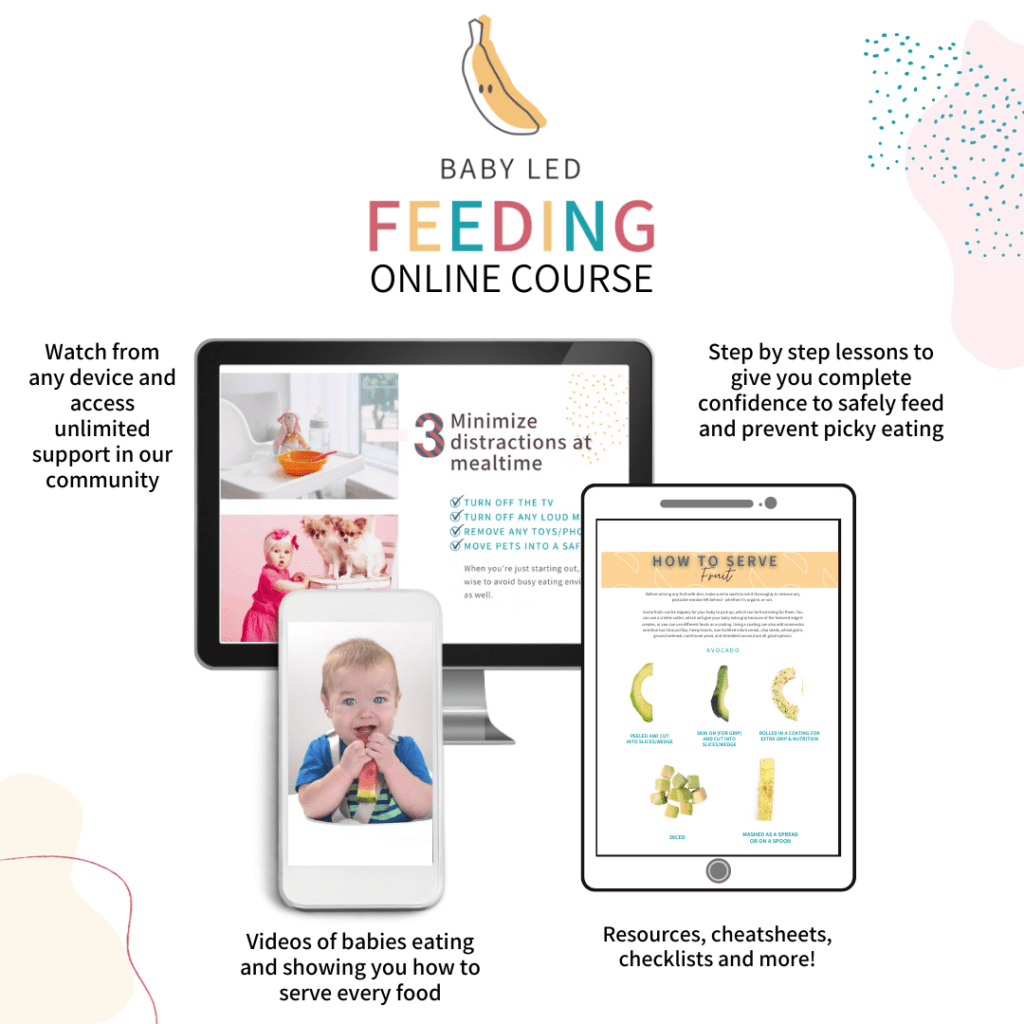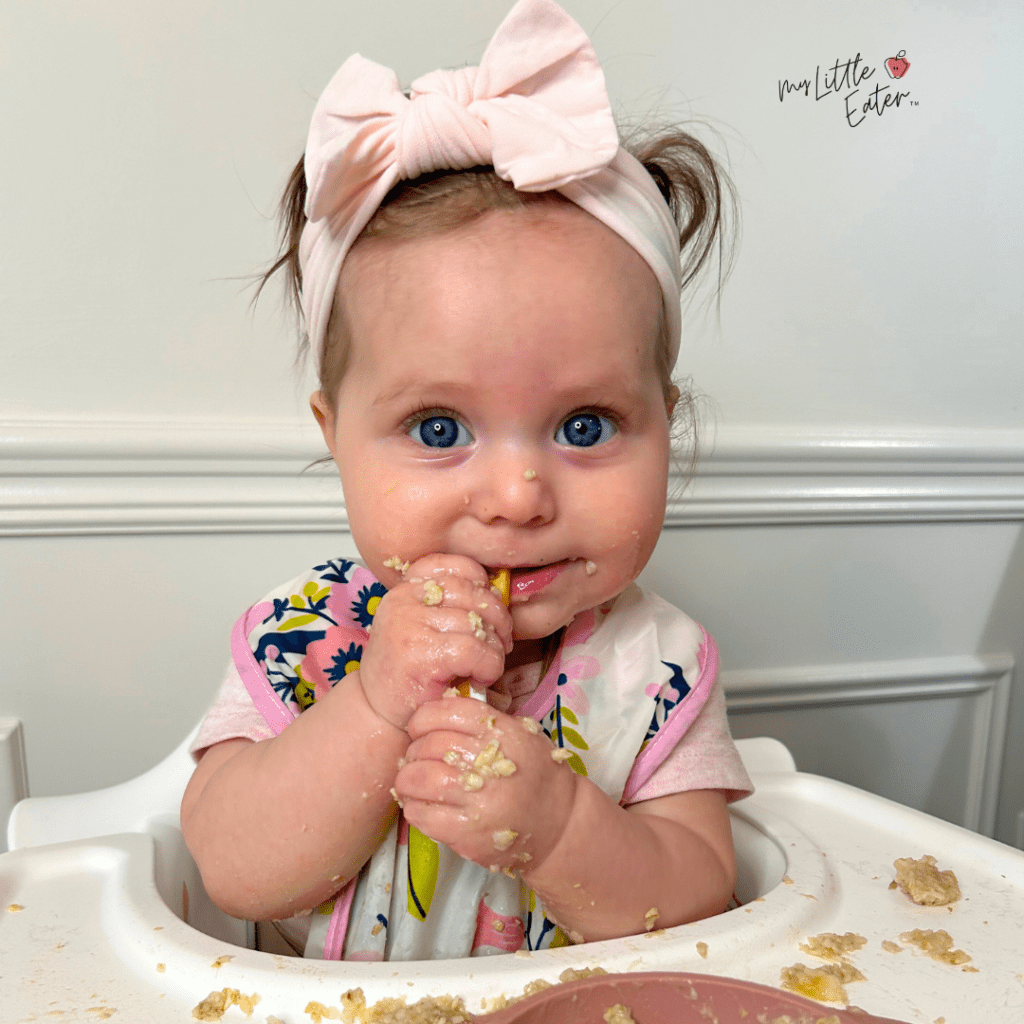This post contains affiliate links, please see our disclosure policy for more details.
The time has come…your little baby is ready to be taken care of by daycare, or another caregiver, and they’re also ready for solid foods. Even if they’ve been at daycare for a while now, this can still be a nerve-wracking change to their routine, with a lot of information that has to be passed on to those caring for them.
We’ve created a complete caregiver guide to baby led weaning (BLW) for this exact reason! Not every caregiver or daycare has experience with starting solids using baby led weaning. And even if you’re going the purée route, to begin with, chances are they don’t know the ins and outs of my signature Texture Timeline™ tool.
Let’s go over everything that you need to cover when speaking with your daycare about introducing solids so that it’s done safely and encouraging your baby to develop the proper eating skills. This isn’t as simple as just telling them this journey has begun.
To make this easier, we’ve compiled a free caregiver’s guide to baby led weaning that you can share with your child’s caregiver. It includes daycare-friendly foods (both age-appropriate finger foods and pureed baby foods), tips for baby led weaning or spoon feeding, and safety info (and bonus material for safely feeding toddlers as well). Click below to download it now!
Let’s back up for just a second…
You’ve gone through the readiness signs for starting solids, you know your baby is ready to begin (or you know they’re close), and you’ve decided how to start. At this point, I recommend speaking with your daycare provider about whether they feel comfortable with baby led weaning and also to get their views on purée feeding (also known as traditional weaning or spoon feeding). Read more about my recommendations for what to discuss and how to approach that conversation about your preferred feeding method with curiosity and understanding, here.
For this article, I’m assuming you’re both on the same page about what feeding will look like – essentially whether you’re doing purées, finger foods, or both. This means that now it’s time for a meeting to go over the nitty gritty details – and this is your roadmap for that meeting!
Table of Contents
1. Discuss the foundations of using a baby-led approach
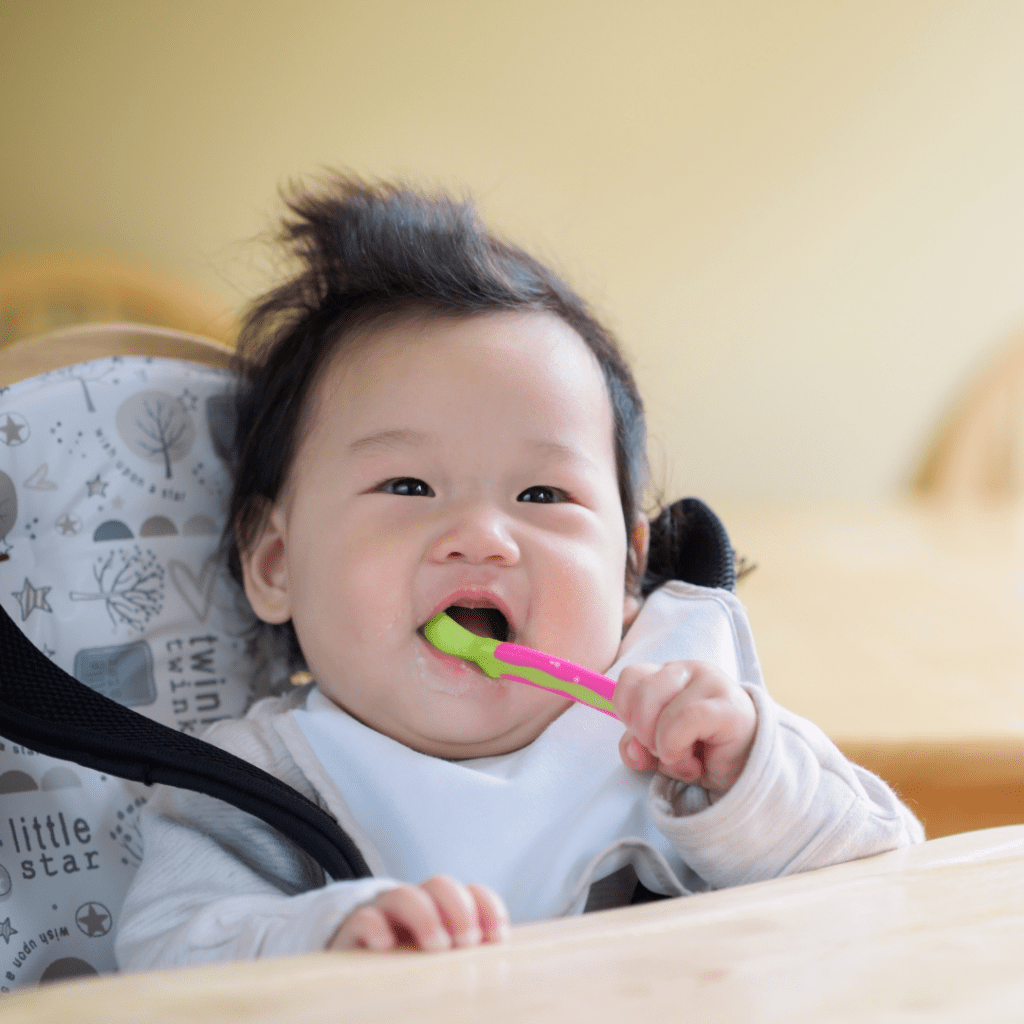
Arrange a time before the actual date of care for the caregiver to visit your home to review the checklists and handouts from the caregiver’s guide to baby led weaning, and open up a meaningful conversation about feeding. Have them sit in during one of your family meals to observe and help feed your baby. This allows them to get familiar with the routine before taking on the job alone, and your baby will be more comfortable with them. You will also be more confident that mealtimes will go smoothly, and that they know how you like it to be done.
For a daycare facility, arrange a meeting with them at the facility in advance, and bring these handouts with you.
Even though you’ve already discussed some of your goals for introducing solids with them, and you’re both on the same page as to how you want to start, it’s nice to do a bit of a refresher for this meeting. This is because it really impacts everything else you’ll be talking about with them.
Let’s review the key points to chat about when going over the basics.
How much solid foods your baby should eat at each meal

Portion sizes are important to review with your caregiver. Many people still believe that babies should be eating a full jar of baby food or one full pouch when they’re having a meal (the individual packages seem like serving sizes, right?). And with baby led weaning, they often find it even more difficult to know how much to offer or when to stop.
The key thing to speak to them about is essentially the whole purpose behind baby led weaning, which is that everything is baby led! And that means…it’s baby’s job to lead the way with how much to eat in a meal!
In other words…there are no portion sizes to aim for!
Babies will eat as much or as little of solid food as they want because they know their bodies best – and we should encourage our child’s caregivers to follow those cues. When we do, we help them grow into their natural body size, prevent under/overeating, develop a healthy relationship with food, and keep mealtime pleasant. To learn more about specific portion amounts (and why they don’t even exist for babies) – get my free guide for how much babies should eat, here.

Help your caregiver become familiar with your baby’s hunger and fullness cues when eating solids so they know just how much your baby wants to eat (even if they aren’t self feeding yet!). Go through these cues with them, and be sure to add in anything specific that you’ve noticed your baby does, as well.
HUNGER CUES ONCE BABY STARTS SOLIDS:
- Baby’s mouth opening and leaning toward food as if they’re accepting or looking for food
- Following food with their eyes
- Getting excited when they see food
- Reaching out to grab food
- Eating at a consistent pace
FULLNESS CUES ONCE BABY STARTS SOLIDS:
- Pushes food/spoon away
- Baby’s mouth closes when you offer food
- Spits food out
- Gets distracted easily – typically if a baby is hungry they eat quickly at the beginning of the meal
- Tries to leave highchair or table
- Throwing food may also be an indication they’re done
- Slowing down the pace of eating
What to do if your baby doesn’t eat what is served
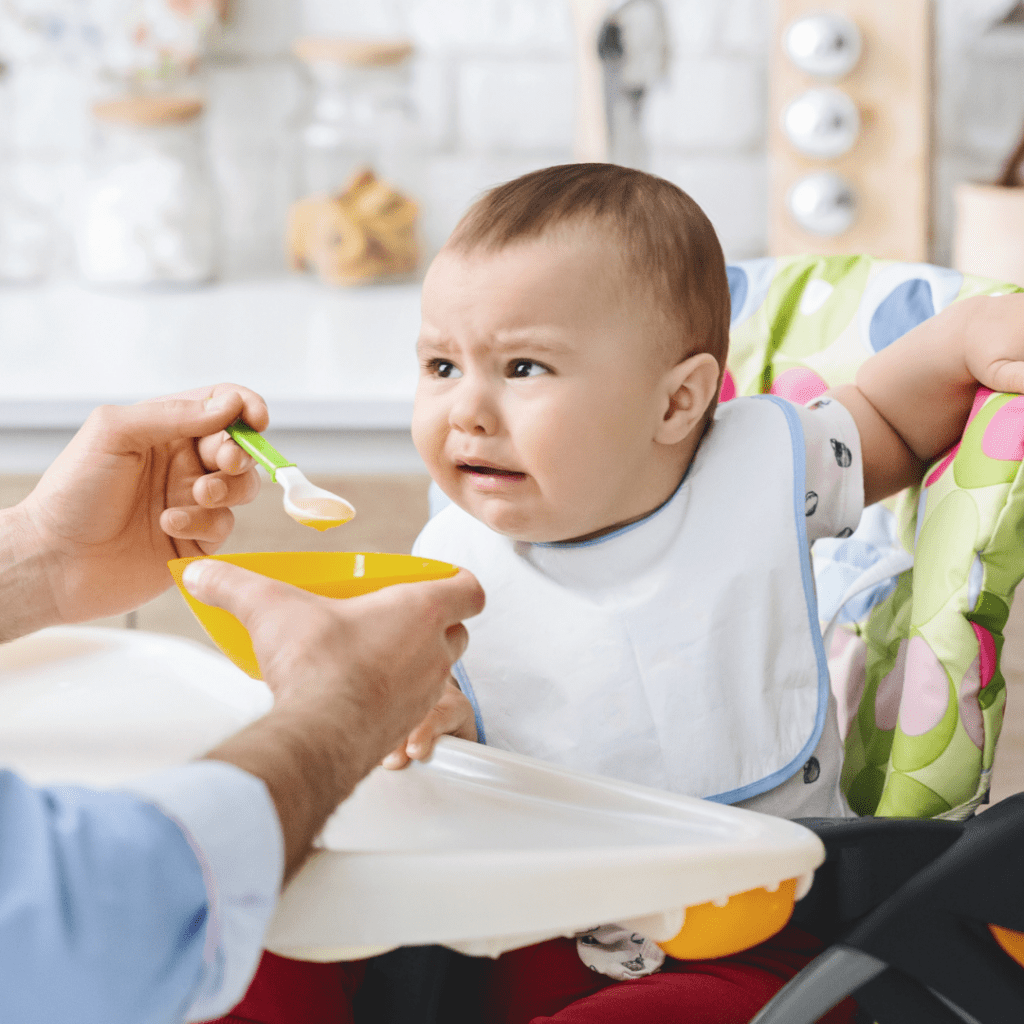
Explain how you would handle it if your baby chooses not to eat what you offered. I find it helpful to actually photograph some pictures of varying amounts your baby will eat day to day or week to week, to show how substantial the variation can be.
Our recommendations (which are all found in the free caregiver’s guide to baby led weaning as well) are to remind them that:
- Your baby gets to decide how much to eat and if they want to eat at all
- Your baby knows their hunger and fullness cues best which is why we don’t influence how much they eat by removing food or pressuring them to eat more
- Your baby doesn’t need a backup meal if they don’t eat the first foods offered (they’ll have another chance to eat soon, either with a bottle or solids)
- And your baby can eat food in whichever order they choose, there’s no need to serve foods individually in a specific order to try and influence what they eat more or less of
2. Go over your baby’s milk schedule

If they’ve been with this caregiver for a while now, how to prep their milk may not be information that’s required, but if daycare is new to them then there are important things to discuss. Either way, updating them on when to offer milk now that solids are being incorporated as well, is necessary. So let’s break it down.
Important note: Many daycare facilities will be familiar with all of these points, and therefore some of these instructions will be unnecessary for them. Use what is applicable to your scenario.
When to offer milk (vs. when to offer solids)
The basics they should know are how many solid meals you want offered, how many bottle feeds, and how long of a gap is needed between both.
For a 6 month old: They only need 1-2 meals per day. Truthfully, depending on your schedule, we recommend offering these at home as opposed to while they’re in care. Offer solids with breakfast and/or dinner to avoid having someone else serving finger foods or spoon feeding purees. This guarantees that you can be the one to choose the first foods introduced and can manage introducing all of the allergens, which can help relieve some anxiety for you. This is especially true in the beginning for those first few weeks when everything is new and we tend to worry a bit more.
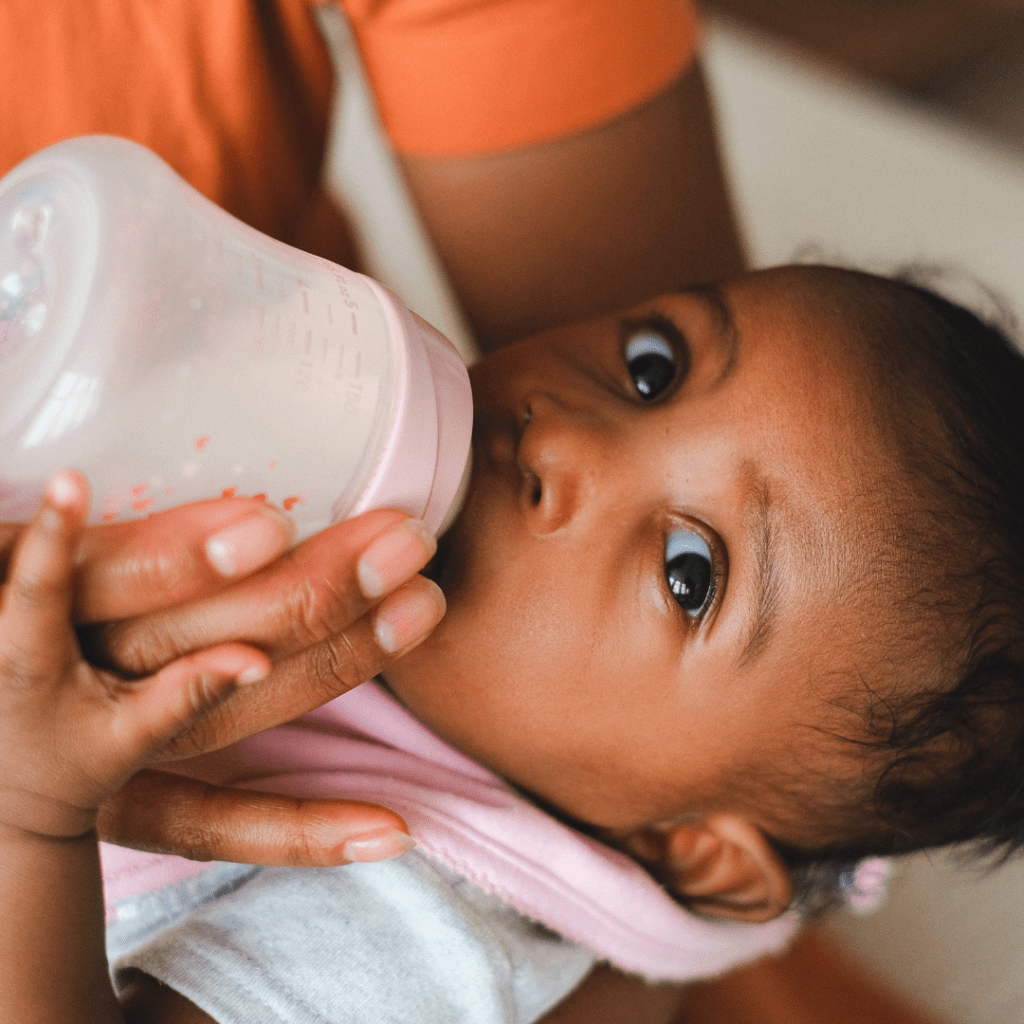
For a 7-9 month old: At this point, they’re probably on at least 2 meals (and by 9 months they’ll be having 3). Which means they are most likely having at least 1 meal with their caregiver. Be clear on when that should be and also note that they won’t be having solid food snacks at this time.
For a 10-12 month old: At this point, you’ll be looking to add in some solid food snacks. You’ll need to keep them updated as to when this will be, but in that first initial meeting, you can hand them the sample schedules available here. Explain how adding in snacks will work so they’re ready for it when you bring it up later.
In all cases, you want to be sure to note that you want bottles to be offered before solids and that they will need between 30 and 90 minutes to develop a true hunger for solid foods after that. I would ask them to bring the typical daycare schedule with them to the meeting so you can both work together to decide on some timings based on what will work best for everyone.
If you have a caregiver coming to your home, have a specific schedule based on your child’s typical wake times ready for them to follow. This will help make naps easier too!
Things to consider for breastfeeding babies
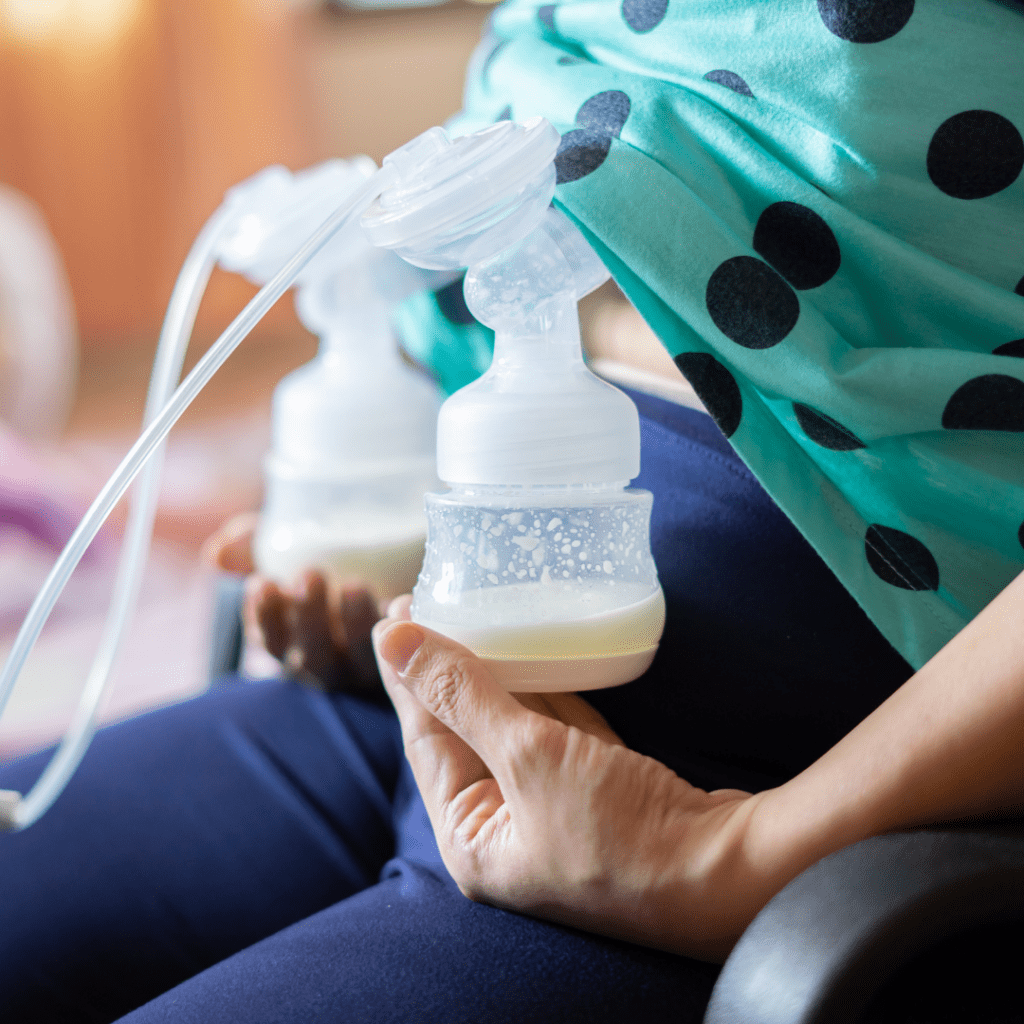
If you are breastfeeding and you usually express and refrigerate breast milk for times when you are away from your baby, show your caregiver how to properly warm and store the bottles. This includes:
- Warming a bottle by standing it in a pitcher of warm water, or by placing the bottle under running, warm tap water.
- Showing your caregiver how to flick a few drops onto the wrist to test that the temperature is no hotter than lukewarm.
- Remind the caregiver to mix the milk carefully to distribute the heat evenly.
- Warn them never to heat bottles in the microwave.
Things to consider for formula-fed babies
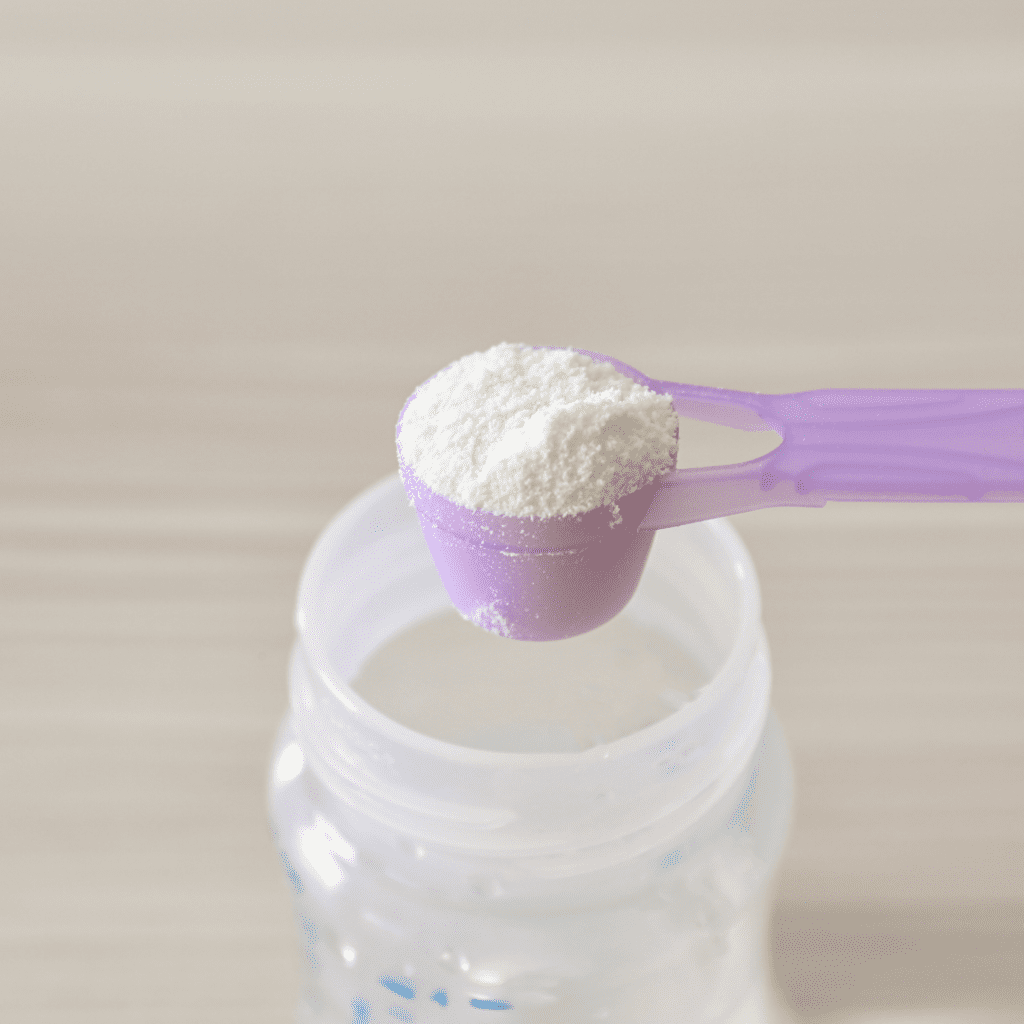
For a formula-fed baby, mix and refrigerate several bottles of formula before going out or leaving them at daycare. Make sure the caregiver is aware about not saving or reusing a bottle that your baby has already drank out of, and that they expire within 1 hour of beginning the feeding.
Alternatively, you can pre-measure out water in bottles for your baby and use a formula dispenser to have the scoops measured out as well. This way all they have to do is mix and serve (and maybe warm slightly if your baby prefers that). It also means that if your baby has fewer bottles than is typical for them, you aren’t having to keep track of how long bottles are good for because they only last in the fridge for 24 hours.
If you have a caregiver coming to your home and you expect them to clean up bottles throughout the day, ensure that you show them what brush, soap, etc. to use on the bottles. And also how to properly sterilize them, if required.
Hunger and Fullness Cues for Bottle-Fed Babies
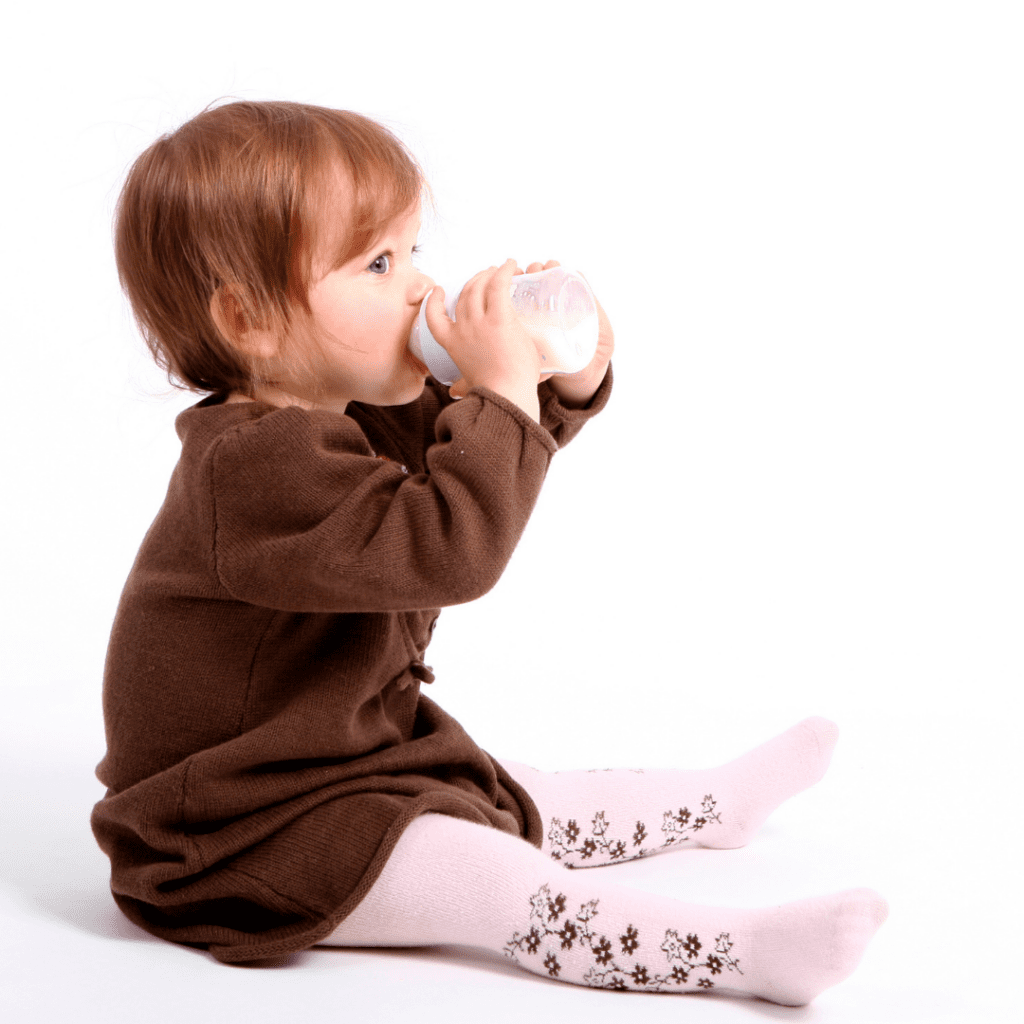
This is important to note for them because we don’t want your baby over-feeding on milk. It can cause stomach upset, overrides their natural ability to listen to their hunger and fullness cues, can make them too full to practice with solids, and can also result in vomiting following a gag while baby eats solid foods.
To be clear, gags happen and are ok (and sometimes vomiting happens too!), but if we can help prevent puking by being mindful of when they’re telling us they’re full – that’s helpful for everyone!
HUNGER CUES FOR BOTTLE FEEDING:
- Rooting – turning head into objects that are close to their face and opening their mouth like they’re looking for a breast or bottle
- Chewing on hands or putting things into their mouth
- Making sucking motions or sounds
- Clenching hands over chest or tummy
- Flexing legs and arms
- Crying or seeming unsettled – this is usually a later sign of hunger and likely they’ll show the other signs first – some babies have a particular cry just for hunger
FULLNESS CUES FOR BOTTLE FEEDING:
- Unlatching and re-latching from the nipple often (note: this could also be a sign of discomfort when feeding)
- Getting distracted easily by things in the environment or fidgeting constantly
- Pushing bottle away from face and closing mouth
- Spitting breast milk/formula out
- Slowing down the pace of feeding
You’ll also want to be sure to note any unique cues that you’ve noticed while feeding your baby because every baby is different and may have other things that they do to signal that they’re all done or still hungry.
3. Make Decisions Around Food Prep for Baby Going to Daycare/Staying with a Caregiver

Now comes more detailed talk about prepping the actual food!! Who’s going to be cooking the food? If they will be, do you have nutritional expectations or concerns? What about allergens?
There is a lot to consider, but again, we’ve got it all broken down for you! And be sure to grab my free caregiver’s guide to baby led weaning for some easy ideas of what to send if you’re the one cooking for them (or give it to your caregiver to use!).
If you’re making the meals for your baby led weaning baby
Things I recommend chatting about:
- Does the food get refrigerated or will you send it in a bag with an ice pack?
- Does it get warmed up? If yes, how warm & how should they test it?
- Is the food already cut to serve or do they need instructions on how to prep it? Our MLE recommendation is to send it ready to serve then it’s one less thing for you both to worry about!
- Are there any foods that you’re not allowed to send with your baby (ie. top allergens like nuts)?
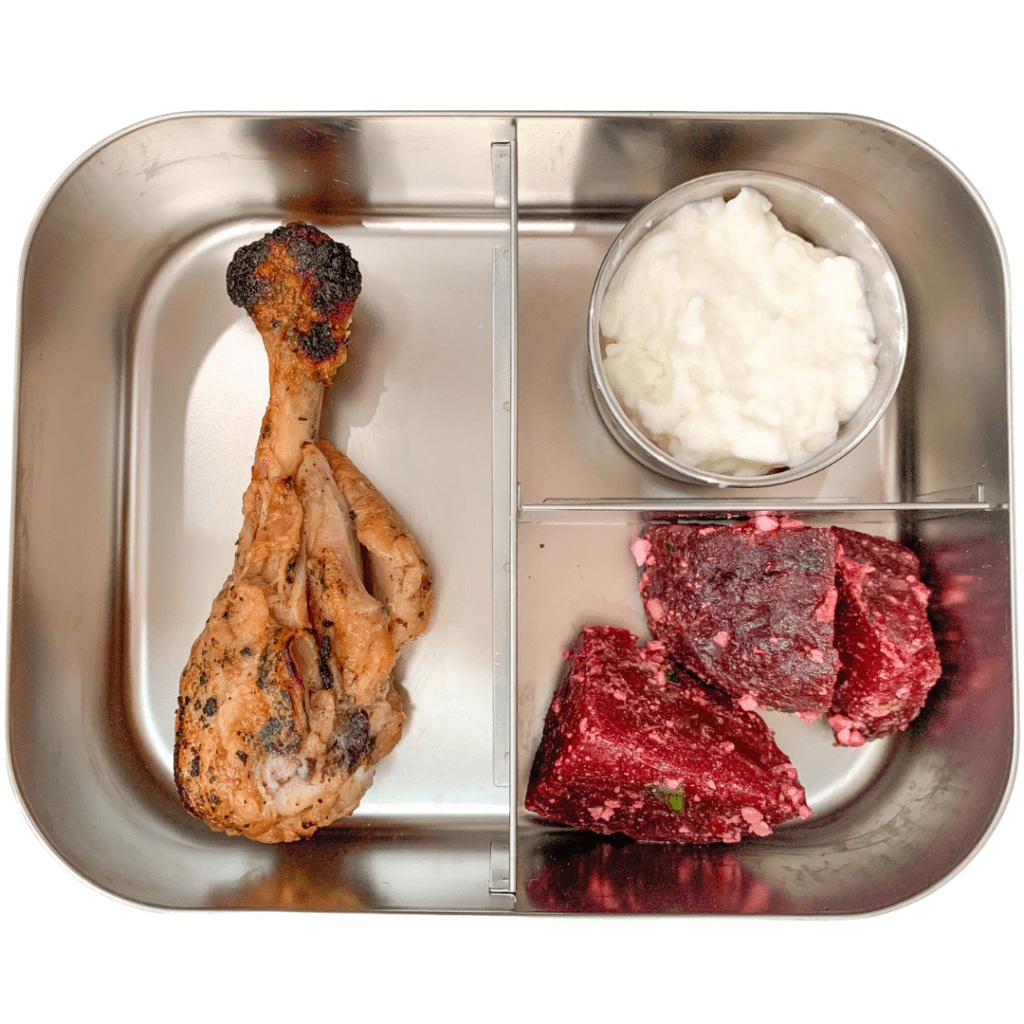
If they’re making the food for your baby to start baby led weaning
This is just a slight bit more tricky – and it really depends on what your situation is.
If a daycare center is cooking their food, there are things you may want to know because in some cases you may decide you’d rather send food from home. Here’s what we recommend asking about to make an informed decision:
- Can you see the menu in advance?
- Do they ever serve allergenic foods? Make sure you’re aware of what days so you and the caregiver can look for symptoms and follow proper protocols.
- Are they home-cooked meals, or frozen, pre-packaged options?
- Do they serve desserts or treat foods with lunch?
If a caregiver that is coming to your home is cooking:
- Go over how to use major appliances in your home (ie. oven, microwave, etc.).
- Show them where you keep safety items like fire extinguishers.
- Show them where to find cooking basics and ingredients.
- Discuss who will decide what is cooked and who is ensuring the ingredients are available (if you need to supply everything but they pick the menu, discuss when you need the menu by).
- Show them where to find cleaning supplies to clean up after a meal – both for your baby and the dishes/eating area.
What if you don’t approve of the daycare menu or of what your caregiver chooses to cook?
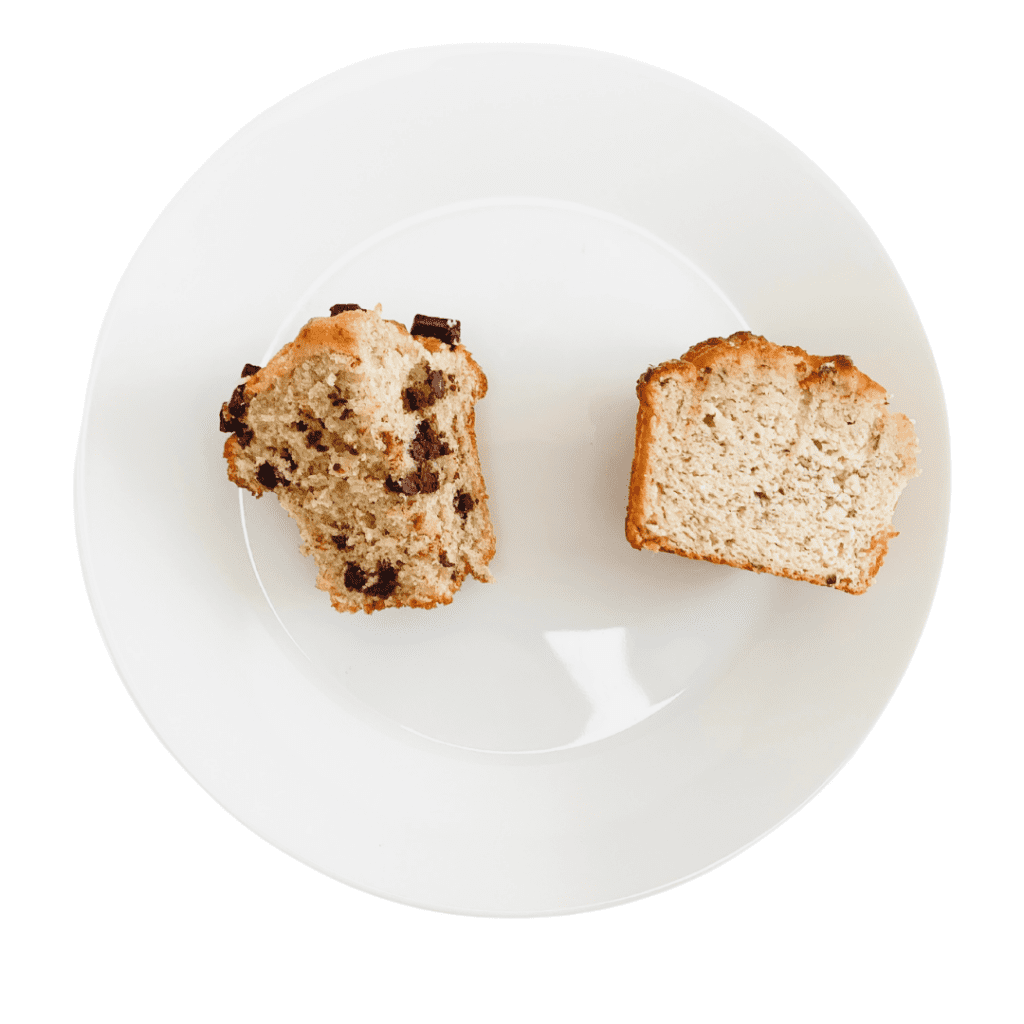
I know how difficult these situations can be to navigate, and I also know how important it is for your baby to be offered healthy foods that will provide them with all of the nutrition they need. So in situations where you see the menu from daycare, or hear what your caregiver plans to cook, and it’s not what you would serve, it can be hard to decide what to do or say.
If your caregiver is doing the cooking and you don’t approve of what they plan to cook…
Our recommendation is to kindly explain to them that you have some specific nutritional preferences and therefore you would like to provide the menu and ingredients for each day. This also means that you’ll have to provide some examples of what you plan to serve (see the free caregiver’s guide to baby led weaning for ideas!) and ensure that they’re comfortable with cooking those. And if they aren’t, then you’ll need to decide how important that is to you, and whether you can do the prep instead (or if you need a new caregiver).
If a daycare is doing the cooking and you don’t approve of the menu…
In this case, you need to weigh the pros and cons. How do you feel about other aspects of the daycare? Is this the only issue that you’ve had with them? And how important is this issue to you?
These answers will be different for everybody! Some will decide that it’s one of many issues and they need to look for a new daycare. Some will decide that it’s something they can compromise on because they truly love everything else about the center. Some will just decide to send their own food because that’s an option as well.
What it usually comes down to is that it’s unreasonable to expect a daycare to switch their menu to accommodate you and your child – except of course in the case of a food allergy. Daycares have to develop menus based on many factors. These can include things like, food allergies to accommodate, parents that have varying views on food and how to support picky eating, minimizing food waste due to the added expense, meeting standard regulations from their governing bodies, and the time they have available to prep meals.

However, I don’t know of many that wouldn’t allow you to provide a meal from home. You just have to decide whether you would want to go that route or not. This doesn’t mean that you can’t make suggestions or recommendations, but you need to be prepared for them to say no.
All of that being said, safety is always first and foremost, so if you find that compromises on safety are being made for whatever reason, be sure to address this immediately and know where you draw the line.
Discuss Food Safety Basics for Baby Led Weaning Foods
We’ll get into table foods to avoid and/or modify for safety in just a bit, but when it comes to cooking, your child’s caregiver needs to be aware of how foods should be cooked in order for them to be safe for a baby. Hopefully, they have a Food Handlers certification, however, a lot of these are specific to babies because we need to be a bit more cautious with them, so they’re still worth going over.
Key things to remind them of:
- Cooking temperatures of meat – all meat needs to be thoroughly cooked (chicken to 165°F, pork and beef to 145°F)
- Eggs need to be fully cooked (so no runny eggs, try hard boiled eggs or scrambled eggs instead)
- Cheese must be pasteurized
- Wash all fruits and vegetables
- Be careful of cross-contaminating surfaces and utensils when cooking raw meat or seafood
- Rice should be rinsed thoroughly to remove excess arsenic
4. Discuss what food groups to avoid or modify with babies
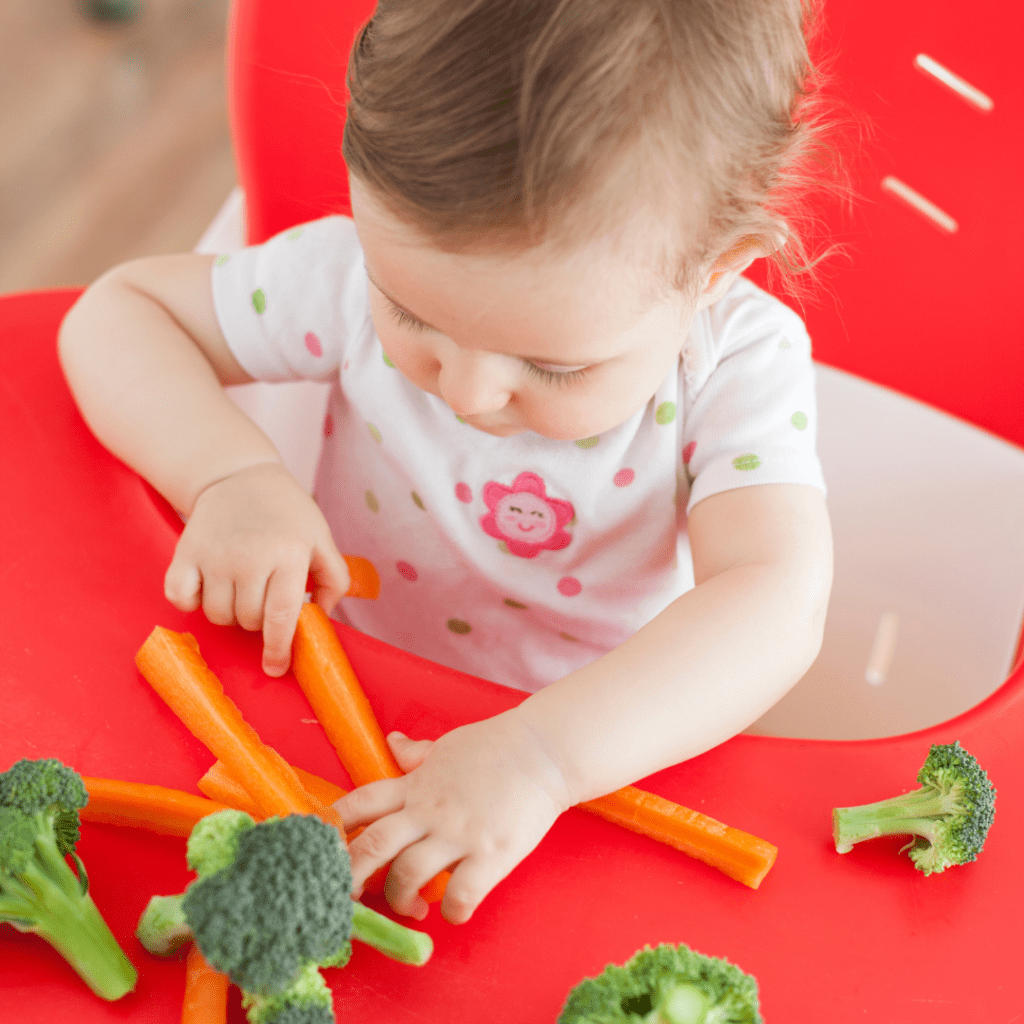
Foods to Avoid Completely
See the caregiver’s guide to baby led weaning for our full list of recommendations, but these are some of what we would recommend including in this part of the conversation…
- Honey (not safe to serve until after 12 months of age)
- Highly processed foods like hot dogs, deli or lunch meats
- Popcorn (one of the top choking hazards)
- Juice
- Fish that is high in mercury (ie. fresh tuna)
- Sugary foods, such as flavored yogurts or chocolate milk (instead opt for unsweetened or plain to avoid added sugars)
- Known allergies (it’s important to go over these and keep them in an easy to access file somewhere – more on that later)
Choking Hazards and How to Safely Modify Them

Again, you can find a complete list in the free caregiver guide to baby led weaning, including tips on safely modifying the top choking hazards – and bonus lists for toddlers up to 24 months+ as well!
Some of the top choking hazards that I find are often overlooked when it comes to babies, are:
- Apples (must be cooked to soft or grated to serve safely)
- Cheese (needs to be very thinly sliced and never cubed)
- Bread (must be toasted for babies up to around 18 months old)
- Thick globs of nut butter or seed butter (always thinly spread these or mix them into something like applesauce)
- Leafy greens (must be cooked and/or blended into something)
PS – To have access to my Texture Timeline™ Food Library with videos showing how to safely serve individual foods (and how to serve them based on their phase in the Texture Timeline™) get the Baby Led Feeding online course. This gives you lifetime access to the library and we’re adding new foods weekly with the goal of eventually having all foods available to view in the library!
Make sure your baby’s caregiver is trained on what to do in the instance that your child chokes. Don’t be shy about asking for a certificate of completion for an infant CPR course. This is a standard requirement for daycare providers, and we recommend following this for in-home caregivers as well. It may be good to provide them with info on where to take a course or provide them with printouts of what to do, as a reminder, and to have them verbally repeat to you what to do.
We love the online course by Safe Beginnings as a great way to learn life-saving skills, without the need for certification. If you or your child’s caregiver need a refresher, or if you’re ok with them not having a certificate, you could request they complete this course or even go over the material together! It’s incredibly thorough and will teach everything that there is to learn about keeping your baby safe and how to respond should the worst happen. Use code MYLITTLEEATER at checkout for 20% off!
5. Discuss allergies or Intolerances for Your Baby

Food Allergies
As mentioned above, it’s important to include information on any known allergies your baby has. Keep this written down in an easy-to-access list for them along with all of the information on what to do and who to call if any allergic reactions should occur.
It’s also important to go over with them any foods that you’ve found to include one of your baby’s allergens that they may not realize to check. When it comes to allergies, especially an allergy to a food that may result in severe anaphylactic responses, you can never be too careful.
You’ll also want to discuss the protocol for introducing your baby to top allergens. Will they do that, or will you? What symptoms should they watch for? What should they do if a reaction occurs while they’re caring for your baby? I’d also discuss with them that you plan on letting them know if you’ve recently introduced an allergen so they can help you monitor for symptoms. Find all the info you need to know about doing this, here.
Food Intolerances

If your baby has an intolerance to certain foods, such as a lactose intolerance, or a soy intolerance – but it isn’t a true allergy – give them the details on that as well. Do you avoid certain foods? Can they have some but not a lot? What’s working for your baby right now? You’ll also want to cover the likely symptoms to expect if they have some and what they should do or how they should treat it.
Another example of something that I would discuss in the meeting would be foods that could cause stomach upset if they eat too much. Sometimes foods like berries (or other high-fiber foods) can cause diarrhea when eaten in large quantities. This is something we suggest making note of for them so that they can help you keep an eye out for any reactions, and to discuss whether limiting those foods is necessary.
6. Discuss Mealtime Tips and Meal Ideas
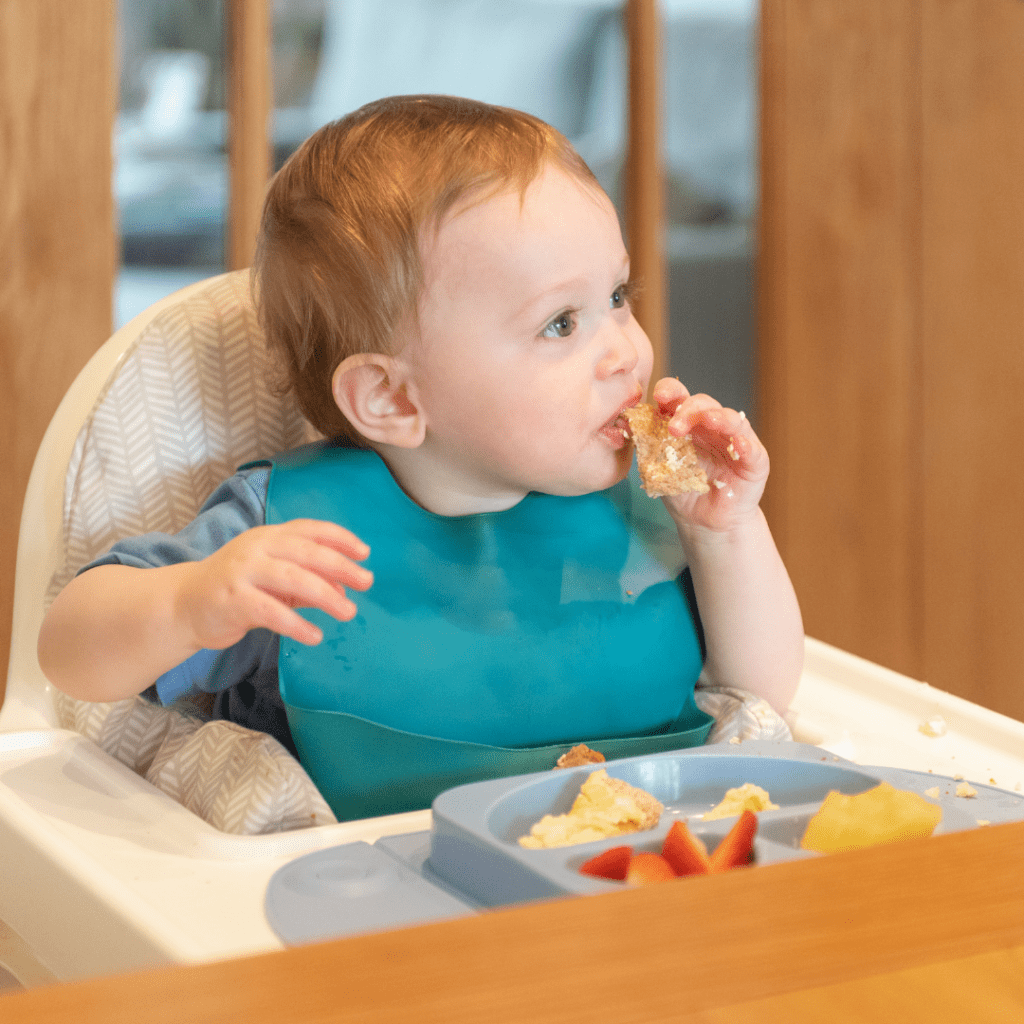
We highly recommend discussing these tips to make mealtime more successful with your baby’s caregiver. This will make their life easier, will keep your baby’s expectations the same when they’re with someone else as they are with you, and ensure your baby will be fed safely. Don’t worry, this whole section can be found in the free caregiver guide in more detail.
Mealtime Mechanics
Basically, this is the description of how mealtime should look. Should the tv be on or off, should the caregiver be sitting to eat with them, how to position baby in a highchair, can they have toys at the table, etc.
The free caregiver guide to feeding your baby goes over everything in detail for babies – and also includes bonus cheat sheets for toddlers! All you have to do is read through them all and see if they have any questions or concerns.
I highly recommend filming a meal or two with your baby to provide some visual examples for their caregiver so they can see how you handle different scenarios and what a typical meal at home looks like.
Meal Ideas

The key points to consider when it comes to a daycare menu for your baby are nutritional needs and any exclusions.
For your baby’s nutrition, you want their first foods to include iron rich foods, high calorie foods, and produce for each meal. You can learn more about balancing your baby’s plate inside my Baby Led Feeding online course.
And for exclusions, avoid any allergens that cannot be sent to daycare, like nuts for example. You’ll want to be careful to read ingredient labels for any pre-packaged foods that you may be sending. You’ll also likely want to avoid packing very messy foods with lots of sauce, or very crumbly food like rice (unless your daycare is very ok with the mess!).
To help make this simple for you, we’ve got over 20 EASY meal ideas (no heating required and nut free) all included in the free caregiver guide for baby led weaning!
Whether you’re doing the meal prep, or you need your caregiver to do it, these ideas are simple and nutrient dense so you know your baby is getting exactly what they need. We’ve included some ideas suitable for 6 months+ and a few more that are suitable after 12 months to carry you into toddlerhood as well.
7. Other Safety Factors to Consider with Feeding
Emergency Contacts
It’s important to always have an easy list of emergency contacts on hand should your caregiver have questions, run into an issue with unusual symptoms from an allergic reaction, choking, or more.
Contact information we recommend leaving with your caregiver/daycare includes:
- Phone numbers for you and your spouse (if applicable)
- An emergency contact (other than you or your spouse)
- Information to contact your primary care physician, dentist, eye doctor, and any other important medical professionals that are part of your child’s regular care
- Poison control
Most daycare centers will have you fill this out, but if you’re hiring a caregiver to come to your home it’s important to leave all of this information for them in an easily accessible location.
Medicines and Proper Dosage
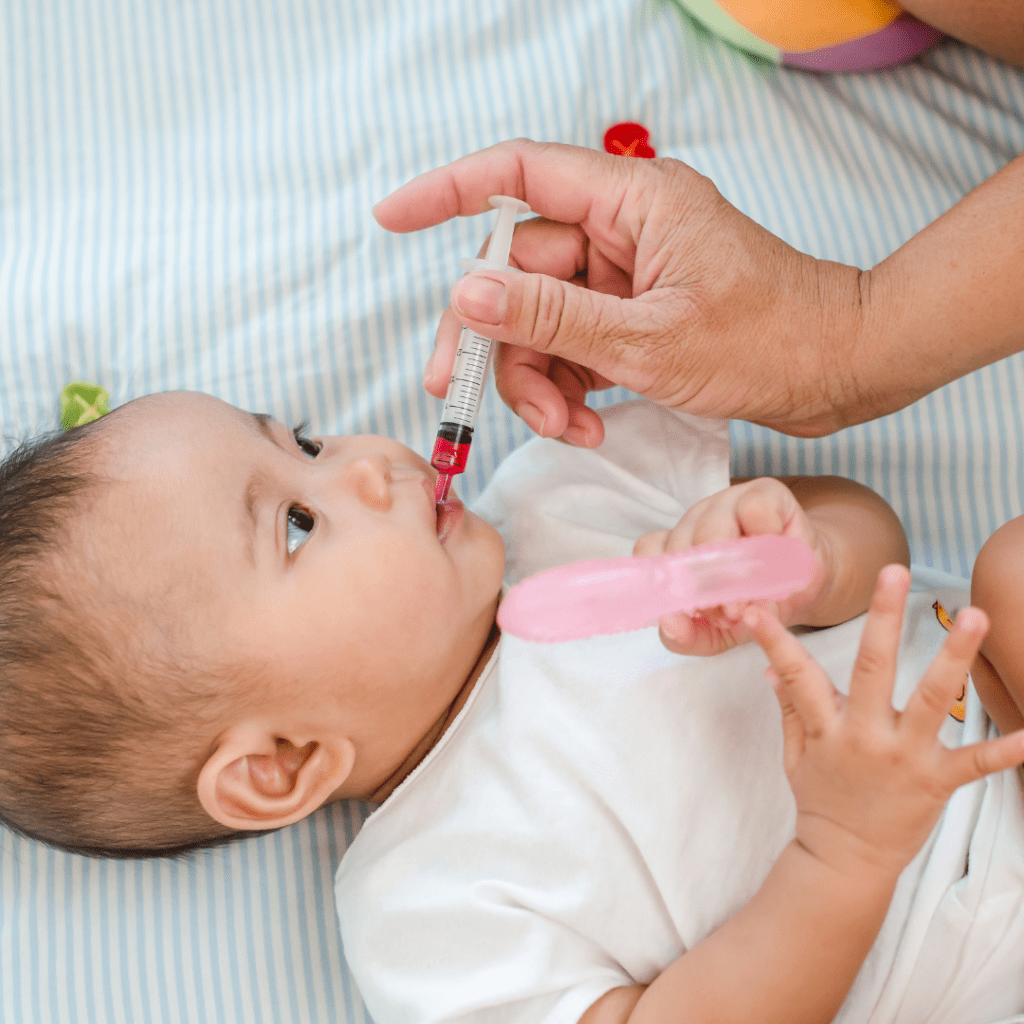
If your baby takes medicine that their caregiver would need to administer, it’s crucial that you go over this with them. I even recommend showing them how to draw up a dosage, and how you recommend administering it. Be sure to include the time at which the medication should be administered as well.
If you’re leaving medicines like Tylenol or Advil available for your caregiver to use at their discretion for things like teething or fevers, then be sure to keep them updated on your baby’s weight and the correct dosage for them. If you’re not comfortable with them administering medications, then go over what the plan will be if your baby develops a fever or appears to be in pain.
For things like vitamins, probiotics, or anything that is administered just once per day, our recommendation is to do this yourself. No need to overwhelm your baby’s caregiver with added information! However, be sure to keep your baby’s list of daily medications and vitamins (such as vitamin D drops) with the list of emergency contacts. If ever an ambulance needs to be called, or they have to rush them to care for something, they will be asked about your child’s medications, and this way they can simply hand over the list.
And if you want to make extra sure that your baby’s caregiver is prepared to embark on this feeding journey with you – it’s time for our baby led feeding online course! When it comes to your baby’s safety and the starting solids journey, we want everyone who cares for your baby to be on the same page. That’s why we recommend grabbing the course and sharing it with your baby’s caregiver too! Let them complete it as well – then you’ll know they have all the knowledge they need to be feeding successfully when you can’t be with your baby.
Was this helpful? Pin it to save for later!
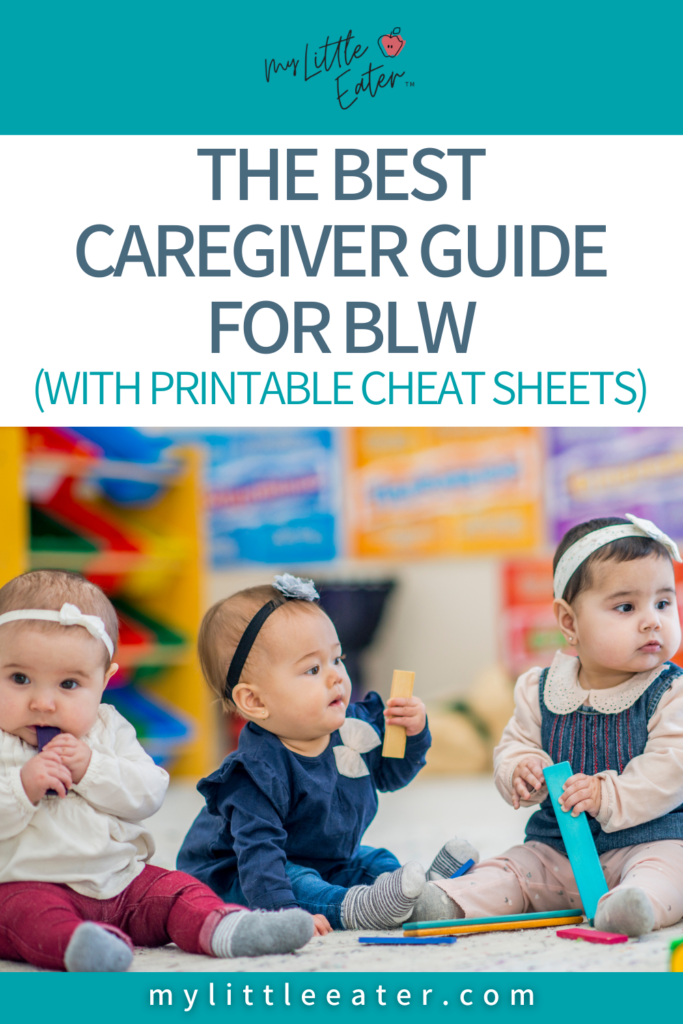

about the author
EDWENA KENNEDY, RD
Founder and lead Registered Pediatric Dietitian at My Little Eater Inc., creator of The Texture Timeline™, and mom of two picky-turned-adventurous eaters.

about the author
EDWENA KENNEDY, RD
Founder and lead Registered Pediatric Dietitian at My Little Eater Inc., creator of The Texture Timeline™, and mom of two picky-turned-adventurous eaters.

